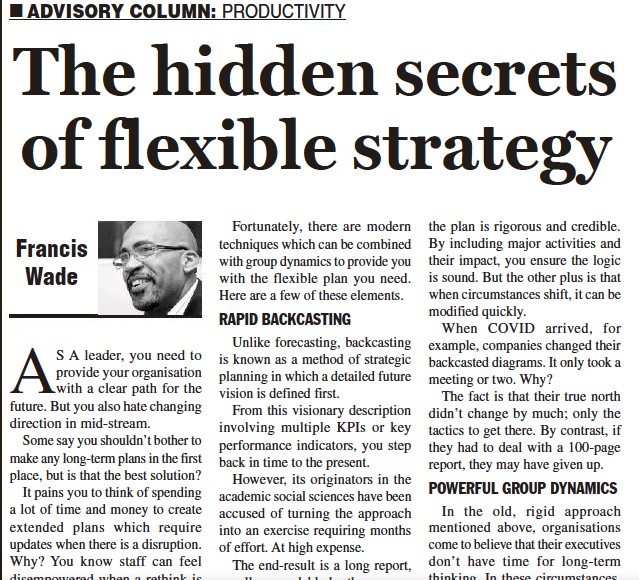As a leader, you need to provide your organisation with a clear path for the future. But you also hate changing direction in mid-stream. Some say you shouldn’t bother to make any long-term plans in the first place, but is that the best solution?
It pains you to think of spending a lot of time and money to create extended plans which require updates when there is a disruption. Why? You know staff can feel disempowered when a rethink is needed.
However, you also realise that having a predetermined, “True North” steadies the ship. It keeps your team focused on the horizon, rather than on the next wave. Confident in the future, they aren’t distracted by their immediate fears. Or social media. Or their email inbox.
But if you stick to the old ways of doing strategic planning, you are likely to fail. Most still try to use a vague vision statement, what Dr. Richard Rumelt calls the “Statement Doctrine.” It’s easy to do, but few remember it.
Some organisations give up without even trying. They simply rename their 5-year list of tactics a “strategic plan” and keep going.
Fortunately, there are modern techniques which can be combined with group dynamics to provide you with the flexible plan you need. Here are a few of these elements.
- Rapid Backcasting
Unlike forecasting, backcasting is known as a method of strategic planning in which a detailed future vision is defined first.
From this visionary description involving multiple Key Performance Indicators (KPIs), you step back in time to the present.
However, its originators in the academic social sciences have been accused of turning the approach into an exercise requiring months of effort. At high expense.
The end-result is a long report, usually unreadable by the average manager.
Fortunately, there’s an alternative in the form of rapid backcasting. In this adaptation, the output is a single matrix. This picture captures the timing of major decisions in your timeline, as shown in the vastly simplified diagram below.

For example, a company with a 27-year plan can record milestones such as the acquisition of another firm (Project 2 above).
But this is just the start. Overseas expansions, outsourcing, new technology implementation, product innovation, re-engineering, rapid process automation…these are all big decisions to be included in your timeline.
One immediate benefit is that the plan is rigorous and credible. By including major activities and their impact, you ensure the logic is sound. But the other plus is that when circumstances shift, it can be modified quickly.
When COVID arrived, for example, companies changed their backcasted diagrams. It only took a meeting or two. Why?
The fact is that their “True North” didn’t change by much. Only the tactics to get there. By contrast, if they had to deal with a 100-page report, they may have given up.
- Powerful Group Dynamics
In the old, rigid approach mentioned above, organisations come to believe that their executives don’t have time for long-term thinking. In these circumstances, they may turn to outside consultants.
At great expense, these outsiders attempt to do the hard thinking required on behalf of the leadership team. Along the way, they present voluminous PowerPoint slides and reports. Usually, their thinking is logical, but it’s not enough. Why?
This approach fails to rely on the real experts – those managers who struggle with the challenges each day. Their inside knowledge is nuanced, and often under-estimated by outsiders.
A very different technique would be to teach them rapid backcasting, then set them loose to do it on their own. They can learn how to think from the future back to the present, and develop a complete matrix of results in hours.
Even though they may not have the big IQ’s of the consultants, collectively, they produce something better. After trading different points of view and conducting some hard negotiations, they have made the most difficult decisions. And now they have a credible plan.
I can say from experience I have witnessed teams making the most challenging choices imaginable under these circumstances. It’s inspiring. In an honest and truthful setting, executives actually step away from their personal interests to seek the best for their companies.
They just need to be given the chance to surprise the company with their courage and intellectual prowess.
As such, when the inevitable disruptions occur, the team can call a fresh huddle, confident in their ability to make the necessary changes. After all, they can unmake any original decisions, as they know how to use the tools.
The naysayers argue that such feats are impossible. “Don’t even try” they advise. But they are wrong. Modern approaches like backcasting can now be taught quickly, and doing so makes all the difference.
Francis Wade is the author of Perfect Time-Based Productivity, a keynote speaker and a management consultant. To search his prior columns on productivity, strategy, engagement and business processes, send email to columns@fwconsulting.com.

